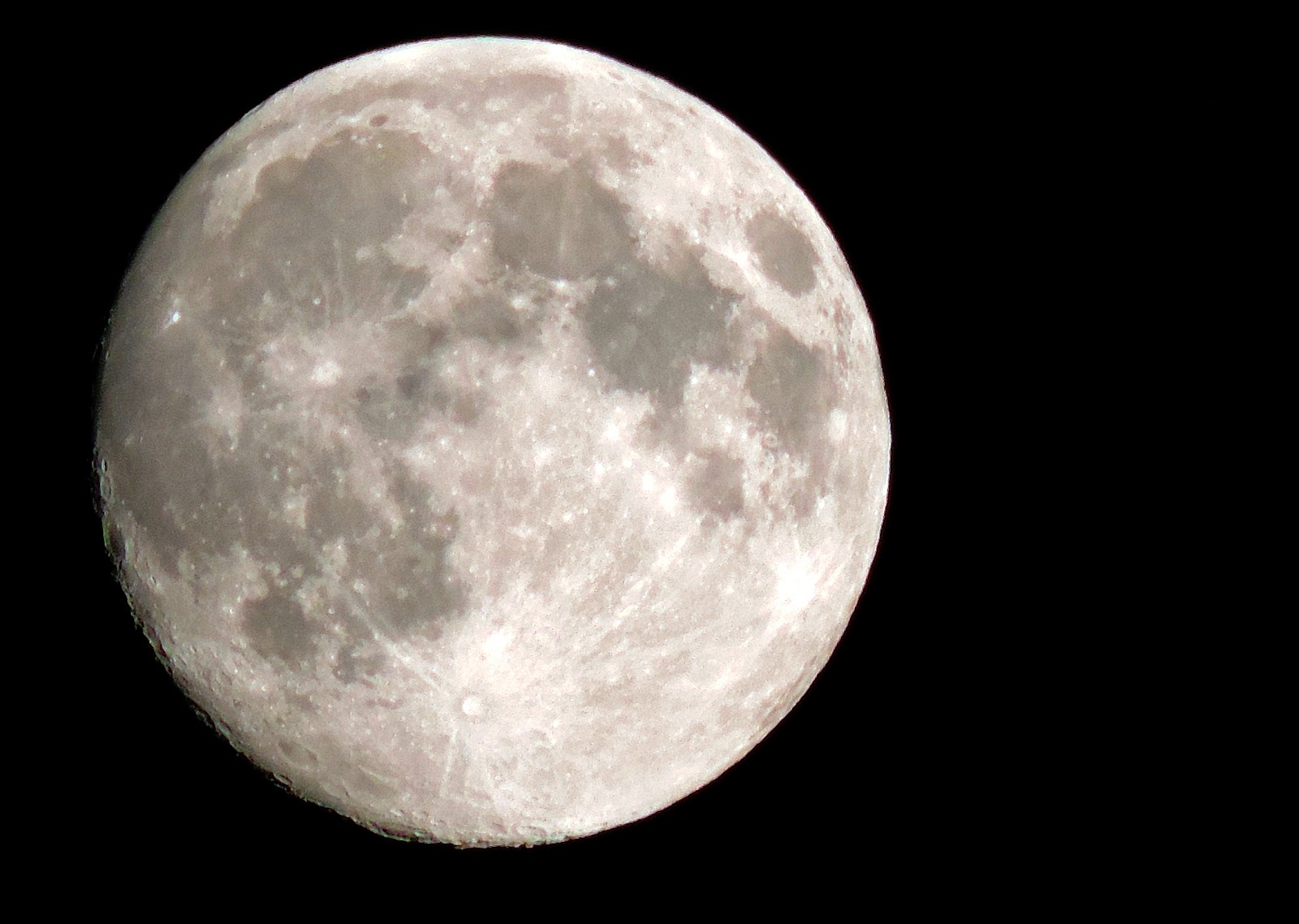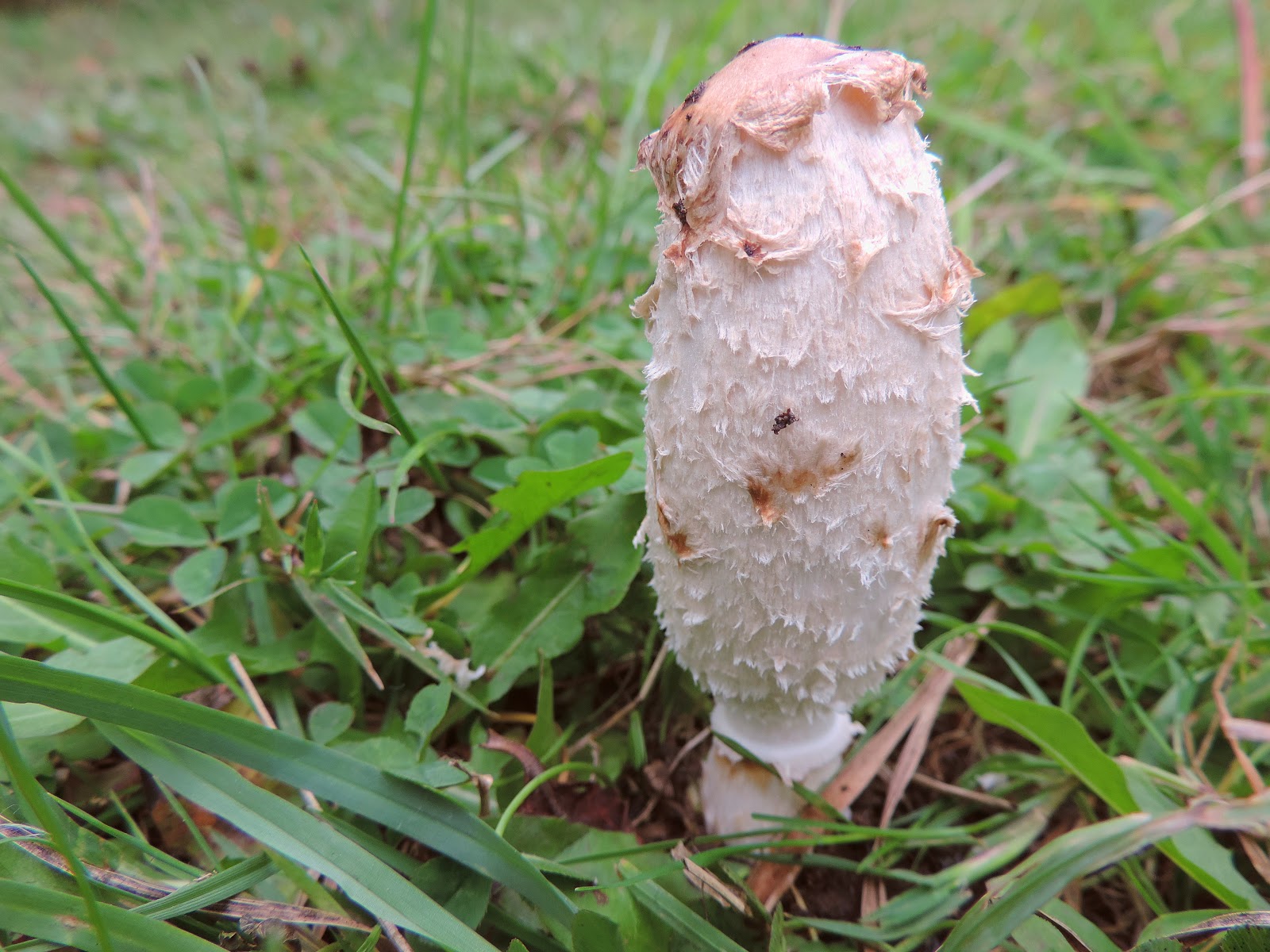I arrived home from visiting my mother to see a wonderful moon above the chimney tops of Chesterton. The sky was unusually clear so I unlocked my front door, grabbed my camera and was back out before the photo opportunity passed me by. The moon flared brightly on my screen, but a bit of twiddling with exposure compensation soon had a reasonable picture in the viewfinder. I took a few shots hoping one would be reasonably free from motion blur. As it happened all the compensated shots were reasonable, though still a little overexposed. I didn't think to go to full manual at the time, I am too used to having to snatch transient opportunities these days. Fortunately post processing made a good job of dealing with what I had.
Waxing harvest moon, taken on an unusually clear evening 7th September 2014. The moon, a 'super moon', was full on the 9th.
I finally caught up with a couple of late flowering plants. There are few plants that come into bloom in August and I didn't see any of them. As it happened some were there all the while and fortunately are still in bloom in early September.
 The first of these late
flowering plants was mint. I had seen what I thought might be mint at
the Visitor Centre. A second visit proved that it was indeed mint,
though I was unsure whether it was wild or part of a planting scheme. A
few days later I found more mint, this time at the bend in the Apedale
Road.
The first of these late
flowering plants was mint. I had seen what I thought might be mint at
the Visitor Centre. A second visit proved that it was indeed mint,
though I was unsure whether it was wild or part of a planting scheme. A
few days later I found more mint, this time at the bend in the Apedale
Road.It is perhaps not surprising that I had missed the plant before as I tend to hurry by this heavily littered area and anyway, everything there is covered in a thick layer of dust. Taste and leaf shape identified the mint as Spearmint.
The Visitor Centre mint has slightly rounder leaves (pictured left), but made a better photograph. I am going to start carrying a soft brush in my pack in the future I think, there have been a few times when I could have done with giving a plant a dusting.
 The second of the late
flowering plants was more of a surprise. I often wonder that I have not
seen heather in Apedale. I assumed
that conditions also suited other plants that can out compete heather. I
had even spent Sunday morning on Bosley Cloud just to see heather in
bloom. It was ironic then, that I found a small patch of heather
(pictured left) in Miry Arena, on my doorstep as it were, that same
afternoon.
The second of the late
flowering plants was more of a surprise. I often wonder that I have not
seen heather in Apedale. I assumed
that conditions also suited other plants that can out compete heather. I
had even spent Sunday morning on Bosley Cloud just to see heather in
bloom. It was ironic then, that I found a small patch of heather
(pictured left) in Miry Arena, on my doorstep as it were, that same
afternoon.I was lucky to see the heather at all, some idiot/s had dug a hole close by to build a cycle jump in the middle of the footpath. It beggars belief that someone had lugged a spade there with the express purpose of damaging the environment and inconveniencing users of the footpath. Unfortunately this is just one more example of damage and nuisance caused by those who insist on cycling where it is not permitted.
Another plant that I might have expected, but had not seen, is Devil's Bit Scabious. This attractive flower is common in areas of nearby Bateswood in an environment that is mirrored by parts of Apedale. I have now found quite a large patch of this plant growing along the track just opposite the entrance with the steps to Miry/Burgess' Wood.
The reason I had not noticed this plant here before, was that the colour is not dissimilar to that of some thistles and knapweed. The patch I have found (pictured left) is some way back from the path and is behind a good growth of those latter two plants. At first glance it just appears that the foreground is fading out. Closer inspection reveals that there is an actual change in colour and plant type.
I was passing the entrance to Watermills Wood from the Apedale Road one evening when I caught a movement in the corner of my eye. I had the camera raised and took a quick 'insurance' shot. Exposure compensation was required and leaves and twigs confused the auto focus so I quickly switched to manual before making a second attempt. My target ran along branches to the other side of the road, I managed to aim and refocus in time for a last shot. The late low sun and the tree cover meant that my shutter speed was down to 1/25th of a second, rather below the 1/2000 recommended at the focal length I was using. I was pretty pleased later to find that I had a usable picture of a rather cute squirrel.
A grey squirrel - Sciurus carolinens
It is not only green plants that fruit in autumn, fungi is really starting to get going. A lot of the fungi appears at the side of the path and unfortunately tends to get trampled rather quickly. I managed to record a couple of specimens before they were broken up. Meanwhile, in the middle layer, in the hedgerow above, hips on the dog rose glow as if red hot.
Left: Shaggy Ink Cap (Coprinus comatus) more shag than ink here, more ink than shag when I saw it the next day. Right: Common Yellow Russula (Russula ochroleuca),
Above: Hips on Rosa canina, a glowing red in the hedgerow.
My patience was rewarded when I took up position near my favourite hawthorn one evening. I had heard birds on my approach, I was hoping that if I waited quietly and patiently, birds that had departed on my arrival might be tempted to come back. Sure enough, after a few minutes that was what happened. First, Long Tailed Tits moved in and hopped and swung in the upper branches. Later the long tails moved off en masse and Great Tits moved in, though the latter preferred less exposed branches.
Left: Long Tailed Tit perched high up on my favourite hawthorn. Right: Great Tit perched in a not quite so conspicuous spot.
I was also lucky enough to see a Buzzard patrolling Miry Arena. It was at some distance and flying high so there was no chance of a close up. It did hang around for some time which gave me an opportunity to practise keeping a moving bird in frame. This is hard enough any way at large magnifications, but is made even harder when the target temporarily disappears while the auto focus is ranging. Of course, if you let the bird out of the field of view then the camera never will focus and it will be hard to find the target again. At long focal lengths 'infinity' is considerably farther than a bird at a useful distance, so fixing focus won't do. I have found that making focus default to infinity does help, this makes it much easier to find the target in the first place. I am slowly learning to predict movement well enough to keep tracking a temporarily invisible target.
I also spent some time over at the large pool to the south east near Milehouse. I was hoping to catch the herons I had seen there or, failing that, the coots that I had seen on my last visit. I saw fishermen as I approached so knew there was no chance of seeing the herons this time. There were a couple of moorhens but there was no sign of the coots. I took up a position in the reeds on the Loomer Road side of the pool, a position that had been occupied by fishermen last time I came, and waited. I was a surprised to see a variety of dragonfly, I didn't know there were any here at all. I managed to get a few shots, I was pleased to get some of Common Darters ovipositing. It is a shame that users of this pool seem to leave even more litter than users of the Springwood fishing pool.
Left: Common Darter (male) and right: A pair of Common Darters ovipositing. I also saw a Brown Hawker, Common Hawker, Southern Hawker and a pair of Emerald Damselfly. Quite a variety for an area that I did not know had dragonfly at all.
While activity may not be so colourful or obvious as it is in spring and early summer, there is still an awful lot going on in the world of nature. Some change is gradual and almost unnoticeable, other change is more obvious as anyone who has seen the 'snowstorm' caused by wind catching willowherb seeds will testify. Some plants will quite literally go out with a bang as their seed pods open like fire crackers, others will catch our eye with brilliant light effects. I think I may have to update this blog more frequently than twice a month.
Going out with a bang. A veritable firework display where these thistle seeds catch the light.












No comments:
Post a Comment